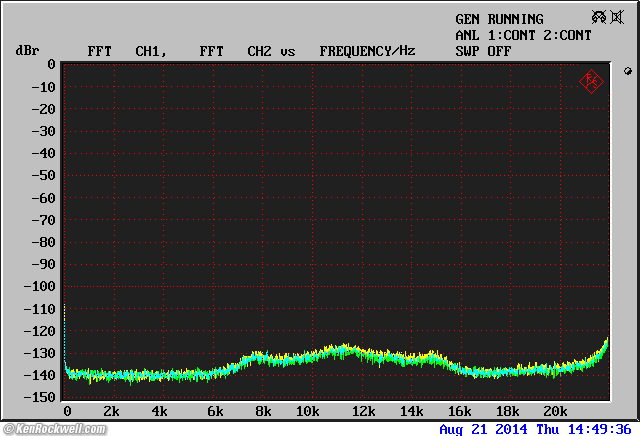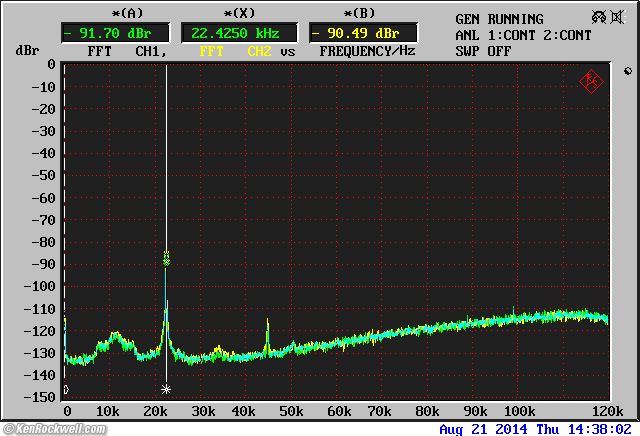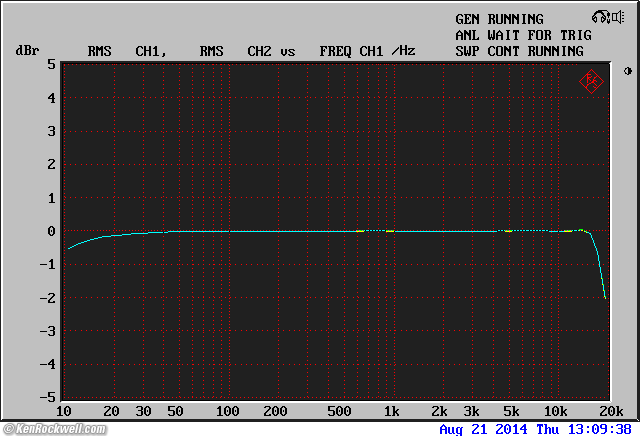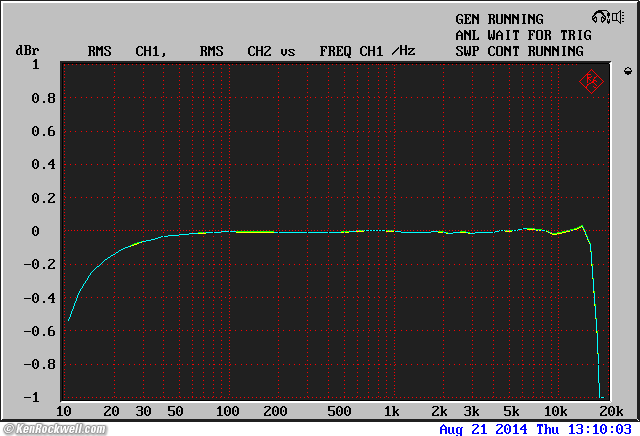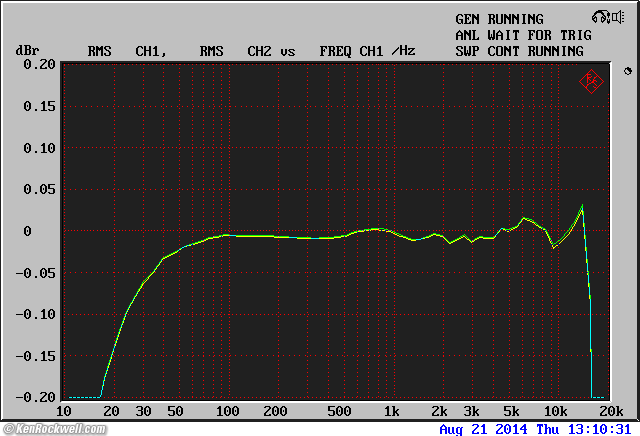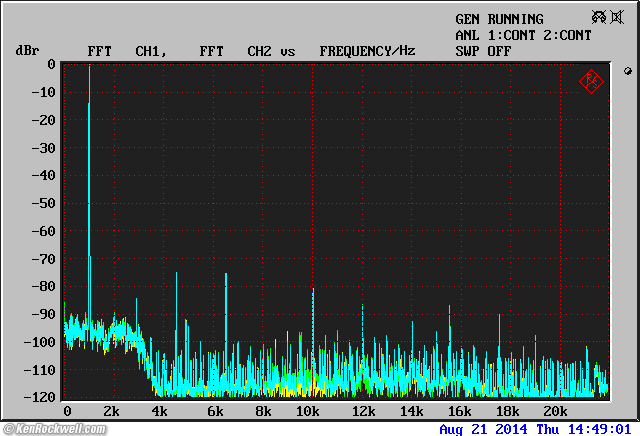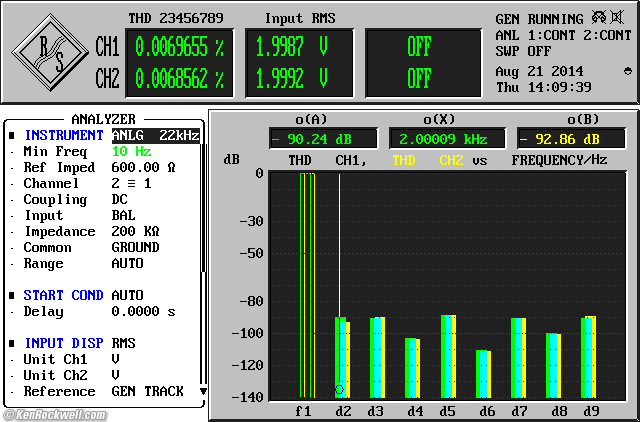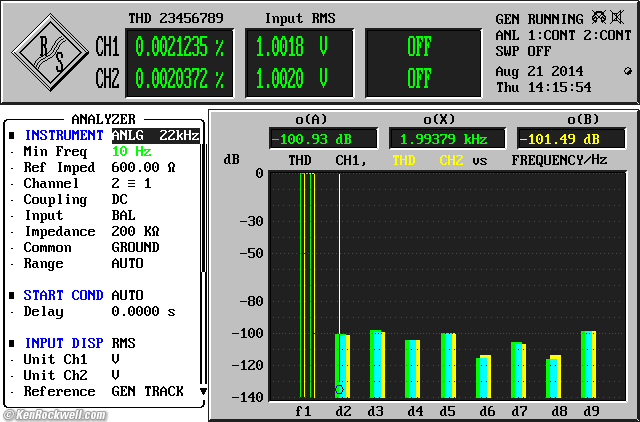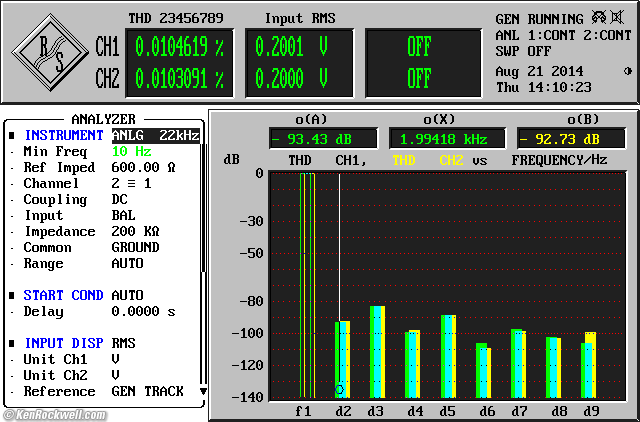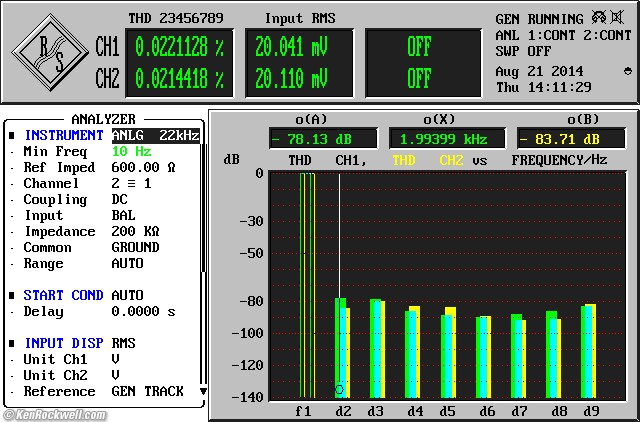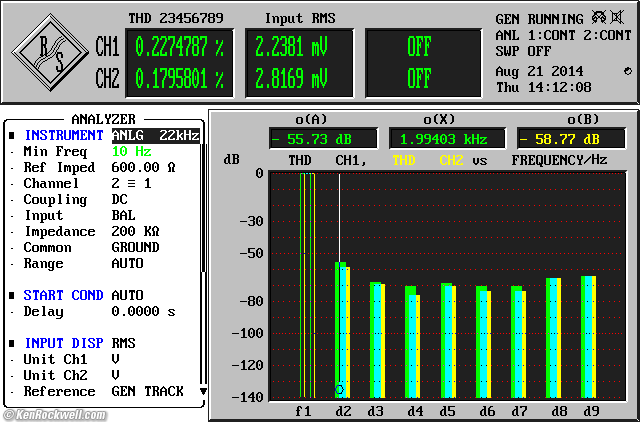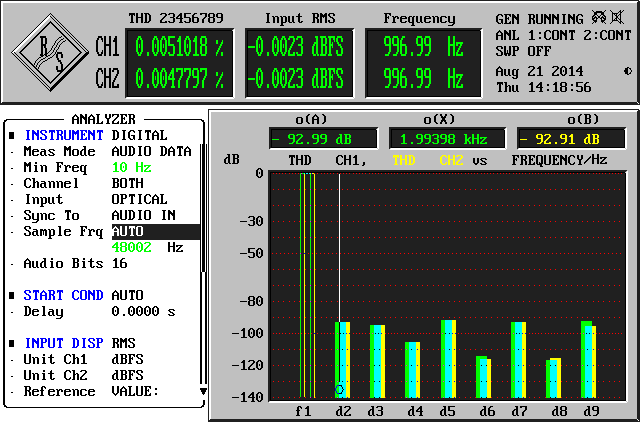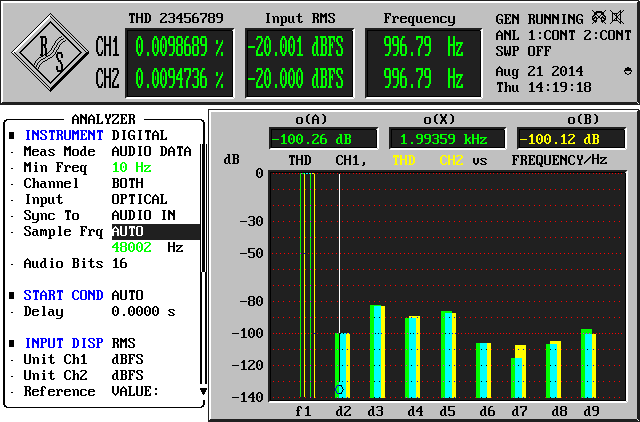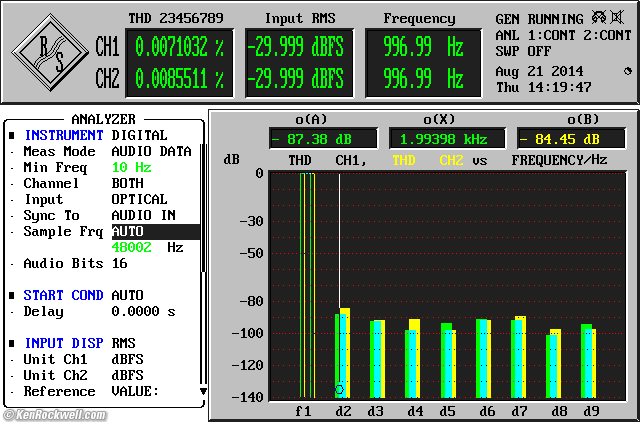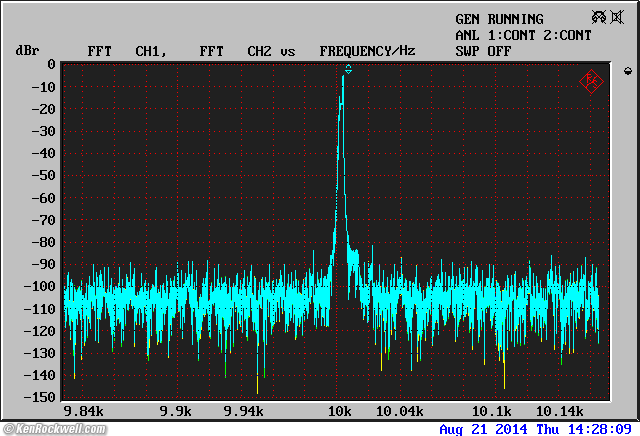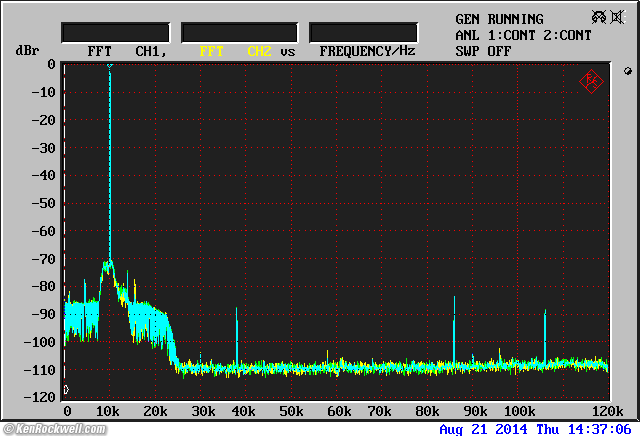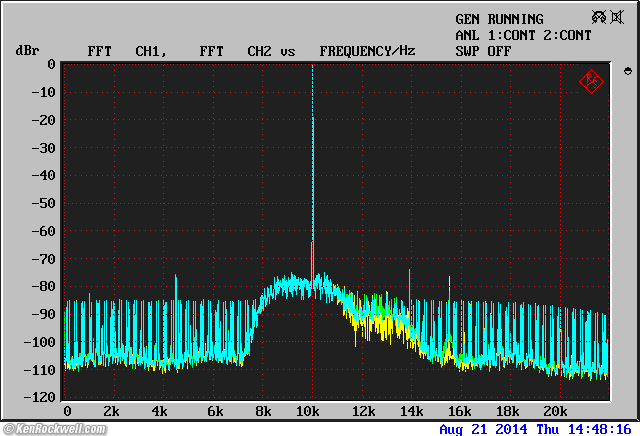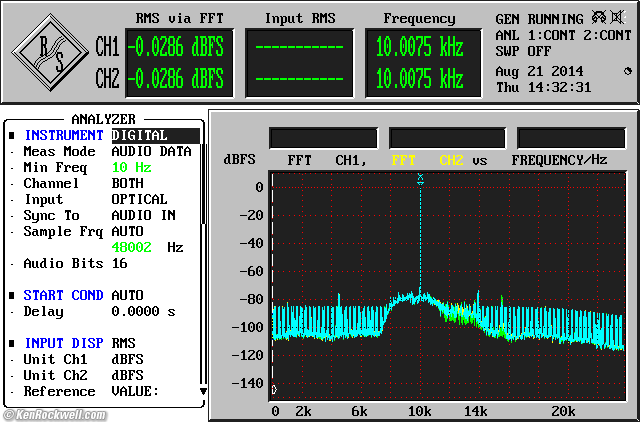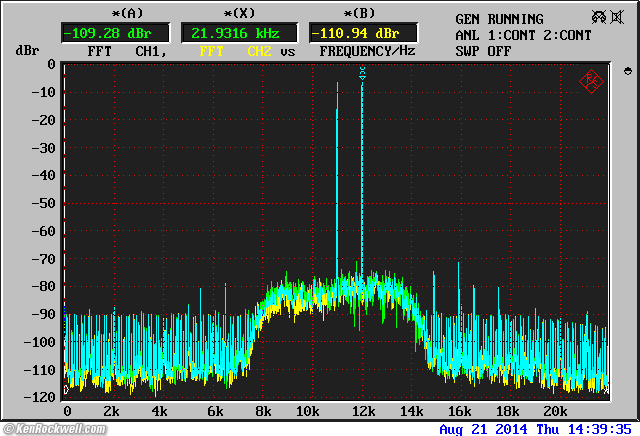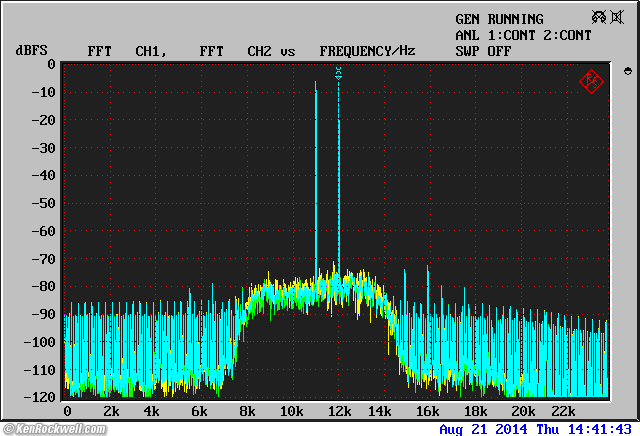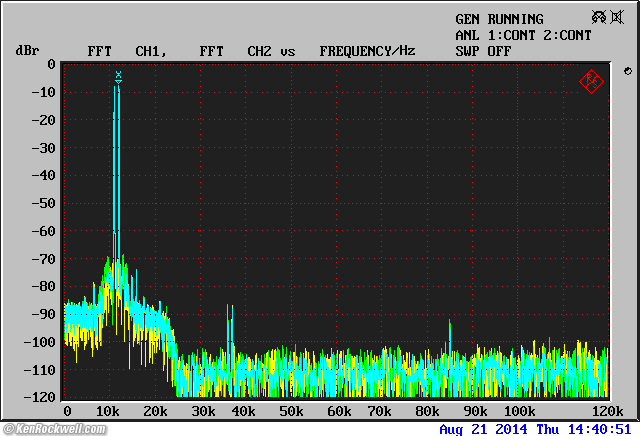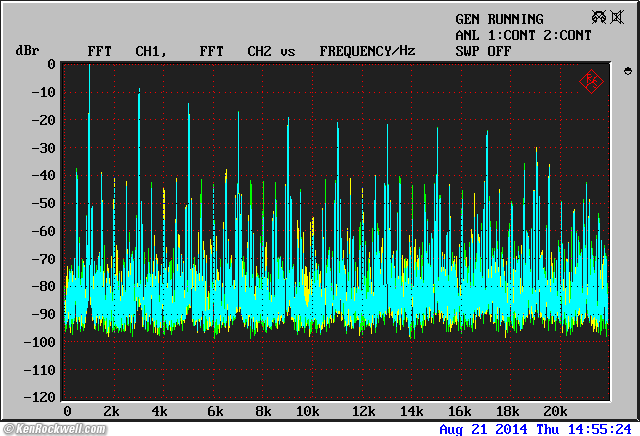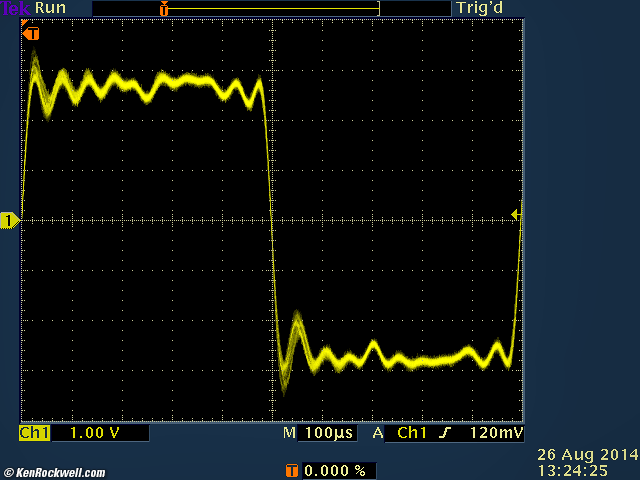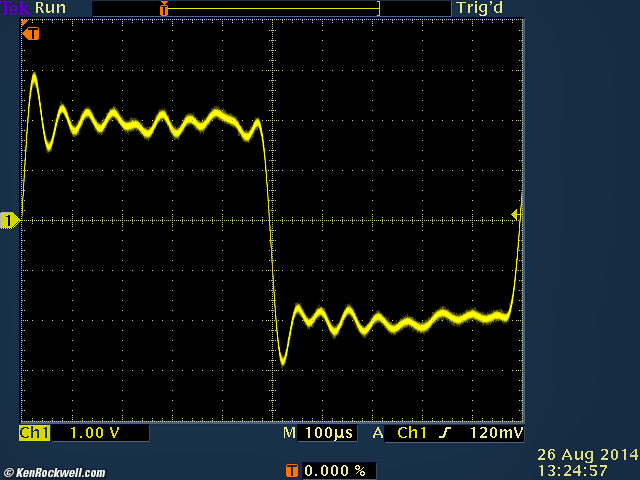Home Donate New Search Gallery Reviews How-To Books Links Workshops About Contact
audioengine B1
Bluetooth DAC (2014-)
© 2014 KenRockwell.com. All rights reserved.
Intro Specs Performance Measurements Recommendations
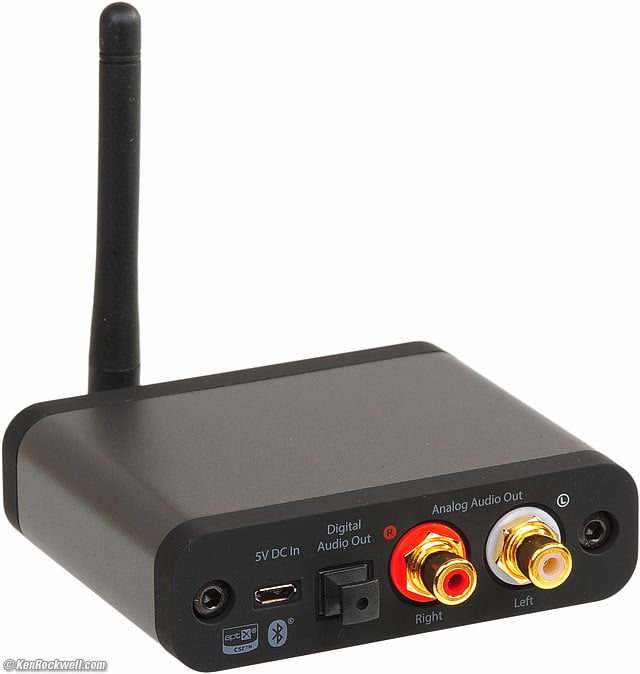
audioengine B1 (5.427 oz./153.85g, about $189).
This free website's biggest source of support is when you use these links, especially this link to them at Amazon or at B&H, when you get anything, regardless of the country in which you live. Thanks! Ken.
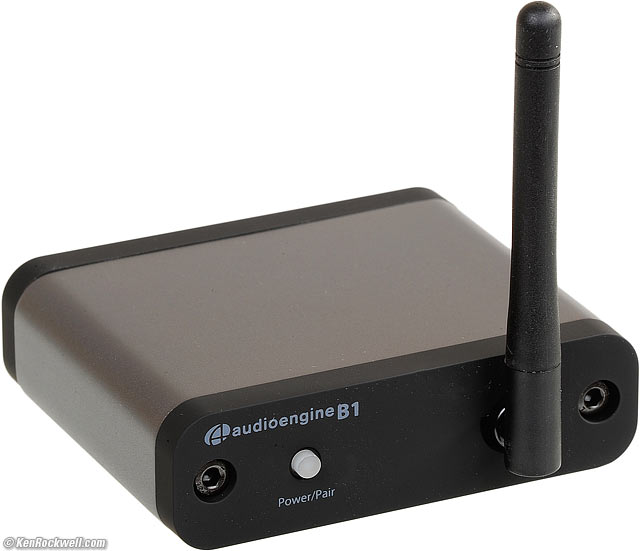
audioengine B1.
September 2014 All Reviews > Audio Reviews > audioengine reviews
See also the cheap and crappy Logitech Bluetooth Adapter and Homespot NFC Bluetooth Adapters.
Inputs: Bluetooth RF.
Outputs: Stereo RCA analog at -10 dBu, TOSLINK digital.
Power: 5V USB, USB AC adapter and cable included.
Good: Great audio quality, sturdy build, easy to use and great range. Comes complete with a fuzzy carry bag.
Bad: Easy to pair, but you have to reconnect manually each time.
Introduction top
Intro Specs Performance Measurements Recommendations
This Bluetooth adapter lets you play your music from any mobile device through any home HiFi or mobile audio system of any age. Presuming you have good music files on your mobile device, they will sound fantastic!
The audioengine B1 is a Bluetooth audio receiver, also known as a Bluetooth speaker adapter. It sets up in less than 60 seconds, it has plenty of range, and it has flawless audio quality. What more could you want?
Setup is easy: plug it in, click on "audioengine B1" in your device's Bluetooth setup, and it's connected without even having to touch the B1. Done! Once set up, it connects moments after power-on, and there are no clicks, mutes or stuttering as I'd get with AirPlay. There are none of the noises or thumps or other dreck I get with the cheap Logitech Bluetooth Adapter or the Homespot NFC Bluetooth Adapter. Bravo!
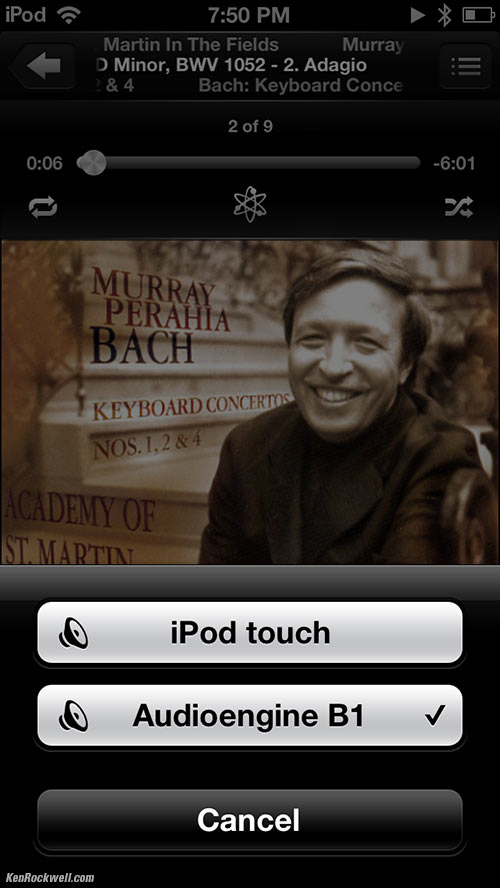
Comes up the same as if it's an AirPlay device (iOS 6 shown here).
Thankfully it lists itself correctly as "audioengine B1" when you look for it in your device, and not some engineer's gibberish as many other Bluetooth devices do.
If you turn it off and come back and turn it on again later, all you have to do is press Play on your device; it will reconnect automatically to whatever it was last connected.
It has plenty of range. I had no problem getting 30-40 feet away through multiple indoor and outdoor walls, stucco and paneling. If you're closer enough to hear your speakers, you're close enough for Bluetooth to work.
When connected to an iPhone 5S, if you get out of range and return while walking around a big house, when you get back in range you'll still be connected, but you'll have to hit Play again. You need a pretty big house to get more than 50 feet away. If you stay disconnected for a while, the B1 turns itself off.
Range is so good that if you carry a connected device to another part of the house overnight, it may still be connected the next day when you turn on the B1 again! You'll need this trick to save yourself a walk around looking for the other connected device: press and hold the B1's button to disconnect the remote device so you can play the device you have with you though it. I'm serious, I had my iPad connected from the night before and had to walk up a story to disconnect it before I could connect another device, before I learned this disconnect trick.
It has a real antenna, so it has much better range than the cheaper Logitech Bluetooth Adapter or the Homespot NFC Bluetooth Adapter.
This audioengine B1 also has far superior audio quality to those cheap adapters. While those other adapters have marginal quality for Hi-Fi use due to noise, high-level distortion and low-frequency rolloffs due to sloppy analog design, the B1's audio quality is limited only by the digital codec used to get data through the Bluetooth system.
The DAC in the B1 is so good that you can't get better results by piping its output to a better DAC — but you can if you want via its TOSLINK output. The audio quality limitations are all in the Bluetooth data manipulation, not in the analog circuits. There's no need to buy any better DAC than the one that's already in the B1.
The B1 has a tough aluminium case with well-marked and solid audio connectors.
Use it at home
Plug the AC adapter into the wall, pair it with your bluetooth device, plug it into any existing stereo, Hi-Fi system or powered speakers, and voila!, you've got an instant super-high-performance Bluetooth speaker system.
You have regular RCA analog stereo outputs, as well as a TOSLINK optical digital output, to plug into anything.
Both outputs are always active, there's no need to select one or the other.
It plays-out everything from your computer, unlike AirPlay. If you want to optimize your speakers and play-out from a Mac or MacBook, Dirac works fine playing via blluetooth.
Use it at work
Your Mac already has Bluetooth so you can play music, movies and everything through this device and into your stereo, and many off-brand computers do, too.
You can connect from iTunes, your browser or other programs to play-out from your computer into the B1.
Use it in your car
Plug its power cable into any USB outlet (or 12 V USB power adapter) in your car.
Plug the B1's output into the AUX input of your car stereo, and you've got the world's best bluetooth mobile audio system — even if your car never had bluetooth before!
Use it while camping
I plugged its power cable into a USB-output solar panel, and it worked fine powered by nothing other than live sunlight.
It will work fine powered by USB power banks and/or solar chargers; anything that has a USB power output.
Specifications top
Intro Specs Performance Measurements Recommendations
Type
Bluetooth 4.0 audio with aptX codec.
Supported Profiles
aptX
A2DP
AVRCP.
Input
Bluetooth RF.
Outputs
Stereo analog RCA, 2 V RMS at 0 DBFS, 57Ω source impedance.
TOSLINK SPDIF optical digital.
Power
5 volts DC at 200 mA.
3-stage redundant regulation.
Universal 100 - 240 V 50-60 Hz AC adapter included.
Range
Not more than 100ft (30m) typical, rated.
Digital to Analog Converter
AKM AK4396.
SNR
>100dB DC to 20 kHz.
THD + N
<0.02%, 1 kHz FS 96 kS/s.
Frequency Response
10 - 20,000 Hz ±0.5 dB.
Crosstalk
> -86dB.
Input Bit Depth
24-bit (upsampled).
Input Data Rate
Determined by Bluetooth.
Output Sample Rate
48 kilosamples per second (48 ksps) measured, not specified.
Audio Delay
~30 milliseconds.
Size
Receiver: 3.5 x 4.0 x 1"
Shipping box 11 x 7 x 3"
Weight
5.427 oz. (153.85g), actual measured for receiver and antenna.
Shipping: 1.0lbs (0.5kg).
Environment
Operating: 32° to 105°F (0°C to 40°C).
Storage: -4° to 115°F (-20°C to 46°C).
Relative humidity: 5% to 95% non-condensing.
Announced
August 2014.
Included
RCA audio cable (3ft/1m).
Power adapter with detachable cable.
Microfiber bag.
Setup guide.
Mechanical
Aluminum case.
Quality
Made in China.
Performance top
Intro Specs Performance Measurements Recommendations
Pairing
The B1 is easy to connect.
You're done in less than 60 seconds and don't even need to touch the B1!
Sound
It has no fans and makes no noise.
It has a relay inside so it has no power-on or power-off thumps.
It's sonically transparent: what goes in is what comes out.
It's sound is perfect: I can't hear any difference between the original uncompressed music and the signal as received through the B1.
Listening with consumer gear, some people will always imagine all sorts of funny things because of perceptual or procedural variations, but listening in a controlled environment with the reference Stax SR-007 Omega Mk II and Stax SR Lambda Professional through the Stax SRM-T1 tube amplifier, the output of the B1 is indistinguishable from the original source in an A/B test.
I ingested CDs into iTunes as 160 kbps VBR AAC files for classical, and 128 kbps VBR AAC files for pop music. I synced these files to my iPhone 5S via USB and played them from its Music app in iOS 7 to the B1 via Bluetooth.
I used a passive mechanical A/B selector to alternate between the calibrated output of a 25-pound Sony CDP-X303ES playing these original CDs, and the output of the B1 playing that those same CDs after having been through all this other gear.
There was no difference audible in my reference system, so there certainly wouldn't be anything audible through lower resolution systems using dynamic headphones or certainly through loudspeakers.
In my controlled environment, the B1 is indistinguishable from the original source as one flips the switch. There's no delay or silence between A and B; the music keeps on playing and if there is even the slightest difference, I'd hear it. I can hear a lot, and in this case there was no alteration of the audio from the original by the B1 for anything from the most carefully recorded classical and choral music to the loudest highly compressed and limited CDs of today's pop music. Even the position of every performer stays rock-solid, and the audible shape of the room is unchanged. Listen as carefully as I do with gear like this, and you hear every page turn, every seat creek, every breath, every finger hitting the key, as well as the size and shape of the room. Nothing changed as swapping the switch.
The only one gotcha I heard was with one CD of Verdi's Requiem where the lead-in noise of the hall, recorded at a very, very low level, sounded a little scratchy as if some digital shenanigans were involved. The room sound of all my other recordings sounded perfect if you're the sort of person who enjoys listening to recorded air-conditioner rumble, but on just this one CD, it was a little off. Even then the music was fine as soon as it came in; just the noise that normally no one even hears was slightly different, and again only on this one CD. Everything else — and I listened for hours and hours and hours — was identical to the original source. It sounded this perfect even with my iPhone 20 feet away (I didn't try this acid test with the iPhone any further away.) Investigating further, it does sound like it's truncating the last bit or so, if you're listening to test signals around -80 dBFS. Even the most dynamic classical music has no music that soft to worry about.
This of course only applies to the files I enjoyed, recorded as AAC. If you use junk formats like MP3 at these same data rates, it the system won't be transparent; you need about 320 kbps in MP3 to sound OK.
I heard none of the main thing I hear when data compression becomes audible, which is the stereo image fading to mono at low signal levels. Reverberation tails and room noise never merged into mono.
I have no idea what codec the B1 was using as I played my ALC, 128 and 160 AAC VBR files into the B1. Whatever it is, it's fine.
If you're a consumer moving cords between gear or pressing input switches on a preamp with anything other than an instant changeover to compare, you won't be able to make a real comparison since your perception changes after 1,500 milliseconds. You'll imagine changes that aren't really there. Set up with matched levels and the two sources in perfect sync with an instant changeover, and nothing changes. You can hear the spit running through the trumpets and everything else with the B1 and good playback gear, and nothing audible changes as it goes through iTunes encoding, your device and then out the B1.
All this, and since the B1 has a full 2 V output, you won't pick up any extra noise as you may with lesser Bluetooth adapters with lower voltage outputs.
Audio Delay (lip sync error)
I didn't notice anything disturbing as I played movies on my iPad.
I'm sure there's some delay, but not enough to make me want to have a cord hanging out of my iPad.
Range
Your house will be different, but in my house, I got 25-50 feet (7-15 meters) through several walls and rooms before reception started to cut out.
If you're getting out of range, the audio simply starts muting. It's obvious and not a gradual effect. It's the proverbial digital cliff.
Your house will be different, and I have no idea why you'd need any more than 15 feet of range anyway: if you're in range of hearing your speakers, you're within bluetooth range.
I didn't try outdoors, where the range should be more.
Software and Installation
None, which is superb!
There is no software, no firmware, and no baloney: just plug-in and enjoy.
Turn-on
I plug it into the Switched power outlet of my preamp.
It fires up and connects immediately to whichever device was last using it.
If you leave it on all the time, it turns itself off when you leave, and you'll have to tap it to wake it up.
There are no thumps as it turns on.
It is so well designed that if you use it correctly, you will never have to touch it to pair, and never have to touch it after you've plugged it in to your system.
Measurements top
Intro Specs Performance Measurements Recommendations
Output Levels Output Impedance Noise & DC Offset
Channel Balance Frequency Response THD
These are measured with a $50,000 Rohde & Schwarz UPL laboratory analyzer as calibrated by Rohde & Schwarz.
Unless otherwise noted, all are RMS as measured from the analog output loaded with 200 kΩ at 0 dBFS at 1 kHz. Signals are from the CBS CD-1 test CD as transferred into iTunes as an ALC (Apple Lossless) file, and played via Bluetooth from an iPhone 5S in its Music app on iOS 7.
The traces are color coded for the Left Channel and for the Right Channel. When they don't lie on top of each other, it's due to channel imbalance.
Output Levels measurements top
at 0 dBFS |
Volts |
200 kΩ load |
1.9995 V |
600 Ω load |
1.8216 V |
300 Ω load |
1.6735 V |
This is the same as a standard CD player (2 V) and 6 dB more than an iOS device (1 V).
Output Source Impedance measurements top
58.5 Ω.
Noise & DC Offset measurements top
Noise
Playing digital zeros:
Left |
Right |
SNR* |
ENOB** |
|
A-weighted |
-93.7 dBV |
-92.0 dBV |
98.85 dB |
16.1 bits |
Unweighted |
-83.4dBV |
-81.6 dBV |
88.5 dB |
14.4 bits |
* referred to maximum output.
** Effective Number of Bits : (SNR - 1.72 dB) / 6.0206.
I read the same values with the iPhone's Music app paused.
FFT while playing zeros. (CBS CD-1 track 5, R&S UPL.)
Wideband FFT while playing zeros. (CBS CD-1 track 5, R&S UPL.)
DC Offset
-0.83 mV left, -2.07 mV right
Channel Balance measurements top
The channels are balanced to within ±0.002 dB of each other. Which is hotter will vary depending on the level.
This is superb. You don't want to know how much "audiophile" gear hits my lab that has its channels out of balance by close to a dB or more, which you can hear.
Frequency Response measurements top
Line output at 0 dBFS, 200 kΩ load. (CBS CD-1 track 11, R&S UPL.)
That's pretty flat.
Yes, it rolls off a bit above 18 kHz, but as musicians know, everything above 16 kHz isn't music; it's noise, so who cares. You pay $3,000 for a 35-pound Sony SCD-XA777ES and engage the special digital filter mode to get the same effect, or just use the B1.
Let's greatly increase the vertical scale and see what happens:
Line output at 0 dBFS, 200 kΩ load. (CBS CD-1 track 11, R&S UPL.)
Perfect, down less than 0.2 dB at 20 Hz.
Let's increase it so far that most lab equipment can't measure it:
Line output at 0 dBFS, 200 kΩ load. (CBS CD-1 track 11, R&S UPL.)
Frequency |
Response |
4 Hz |
-2.6 dB |
8 Hz |
-0.89 dB |
17 Hz |
-0.21 dB |
32 Hz |
-0.06 dB |
. |
. . . |
10 kHz |
-0.01 dB |
12.5 kHz |
+0.001 dB |
16 kHz |
-0.05 dB |
18 kHz |
-0.59 dB |
20 kHz |
-2.1 dB |
THD: 0.006% (-84 dB) measurements top
FFT while playing 1 kHz at 0 dBFS. (CBS CD-1 track 1, R&S UPL.)
Analog output harmonic content, undithered 1kHz sine wave at 0 dBFS. (CBS CD-1 track 1, R&S UPL.)
Analog output harmonic content, undithered 1kHz sine wave at -6 dBFS. (CBS CD-1 track 18, R&S UPL.)
Analog output harmonic content, undithered 1kHz sine wave at -20 dBFS. (CBS CD-1 track 18, R&S UPL.)
Analog output harmonic content, undithered 1kHz sine wave at -40 dBFS. (CBS CD-1 track 18, R&S UPL.)
Analog output harmonic content, undithered 1kHz sine wave at -60 dBFS. (CBS CD-1 track 18, R&S UPL.)
Just for fun, let's see how much of this minimal distortion is from the B1's DACs, and how much is inherent in the undithered 16-bit signal:
TOSLINK digital output harmonic content, undithered 1kHz sine wave at 0 dBFS. (CBS CD-1 track 1, R&S UPL.)
Aha! The digital signal does have less distortion than the B1, at least at full scale. I was more interested in the source of rising distortion at lower levels:
TOSLINK digital output harmonic content -20 dBFS. (CBS CD-1 track 18, R&S UPL.)
Aha! The -20 dBFS distortion of the original digital source is about the same as what's coming out of the analog outputs.
TOSLINK digital output harmonic content -20 dBFS. (CBS CD-1 track 18, R&S UPL.)
I'm actually measuring the digital datastream itself in a laboratory, no DAC required. This is what comes out of the TOSLINK output.
Output Spectra measurements top
10kHz 11+12kHz IMD Square Wave
Let's see a zoomed FFT of a 10 kHz sine wave. Let's see what sort of spurs surround the carrier, which show us internal jitter:
Zoomed spectrum of 10 kHz 0 dBFS sine wave. (CBS CD-1 track 9, R&S UPL.)
The noise floor is higher than from a direct source due to the lossy Bluetooth coding, but at least there's no jitter (spreading of the skirts). I can't heat noise that low, even if a CD player direct is 40 dB better at this.
Wideband spectrum of 10 kHz 0 dBFS sine wave. (CBS CD-1 track 9, R&S UPL.)
Aha! See the raised noise from 0 to 24 kHz? That's from the coding; the noise floor drops when playing silence.
Here's a look at just the audible band:
Spectrum of 10 kHz 0 dBFS sine wave. (CBS CD-1 track 9, R&S UPL.)
And here's the same thing from the TOSLINK SPDIF output to see if it's any different:
TOSLINK output: spectrum of 10 kHz 0 dBFS sine wave. (CBS CD-1 track 9, R&S UPL.)
As I suspected, the DAC is essentially perfect; the limitation here is the Bluetooth coding to move this data from the iPhone at a reduced data rate that Bluetooth can handle.
Let's see how 11+12 kHz IMD look:
IMD spectrum at 11 kHz and 12 kHz 1:1. (CBS CD-1 track 13, index 2, R&S UPL.)
As expected, the same noise floor rise spectrally near the signals.
Here's the same thing direct from the TOSLINK output:
IMD spectrum at 11 kHz and 12 kHz 1:1. (CBS CD-1 track 13, index 2, R&S UPL.)
The DAC is reproducing exactly what's fed to it.
Here it it wideband, from the analog output of course:
IMD spectrum at 11 kHz and 12 kHz 1:1. (CBS CD-1 track 13, index 2, R&S UPL.)
1,002.27 Hz 0 dBFS square wave. (CBS CD-1 track 16, R&S UPL.)
This is poor. A square wave should contains odd-order harmonics only. Most outboard DACs can't handle this foolishly overloaded signal and add even-order harmonics as the result of clipping or truncation, and in this case with the additional Bluetooth coding, looks ugly.
Even if square waves are your thing, I heard nothing wrong with music recorded way too loud on commercial CDs as played through the B1 - they sounded indistinguishable form the output of a proper player that reproduces perfect square waves.
Square Wave measurements top
1,002.27 Hz 0 dBFS square wave at full playback level in Mac Pro. (CBS CD-1 track 16, TEK TDS3052.)
1,002.27 Hz 0 dBFS square wave played with Mac Pro volume down a bit. (CBS CD-1 track 16, TEK TDS3052.)
Aha! The full-scale square wave reduces the level of the first overshoot, compared to the reduced level square wave.
Actually I'm impressed that anything that looks this much like a square wave made it through a lossy codec at all.
Actual Power Consumption measurements top
1.5 W from 120 VAC, play.
1.2 W from 120 VAC, off.
5 V USB current not measured.
Recommendations top
Intro Specs Performance Measurements Recommendations
At any price, the audioengine B1 is a great DAC. It sounds great, with a completely silent background, full 2 V output, smooth detailed sound and full infrasonic bass respoonse.
For best resuklts, leave your bluetooth device's volume at maximum for maximum output from the B1, and vary playback level with your Hi-Fi's volume control.
It sounds marvelous for playing-out from my mobile devices into my Hi-Fi. Not only does everything sound exactly like the source, there's no low-frequency rolloff so all my bass and subsonics are left intact, and the B1 is well behaved with none of the hiss or beeps or big switching thumps that plague the cheap Logitech Bluetooth Adapter and Homespot NFC Bluetooth Adapter.
While the cheap Logitech Bluetooth Adapter and Homespot NFC Bluetooth Adapter used to be all we had and I lived with their faults, out to the trash they go now that the B1 solves all their problems.
Bravo!
If you find my research helpful, this free website's biggest source of support is when you use these links, especially this link to them at Amazon or at B&H, when you get anything, regardless of the country in which you live.
Thanks!
Ken.
Help me help you top
I support my growing family through this website, as crazy as it might seem.
If you find this page as helpful as a book you might have had to buy or a workshop you may have had to take, feel free to help me continue helping everyone.
If you've gotten your gear through one of my links or helped otherwise, you're family. It's great people like you who allow me to keep adding to this site full-time. Thanks!
If you haven't helped yet, please do, and consider helping me with a gift of $5.00.
As this page is copyrighted and formally registered, it is unlawful to make copies, especially in the form of printouts for personal use. If you wish to make a printout for personal use, you are granted one-time permission only if you PayPal me $5.00 per printout or part thereof. Thank you!
Thanks for reading!
Mr. & Mrs. Ken Rockwell, Ryan and Katie.
Home Donate New Search Gallery Reviews How-To Books Links Workshops About Contact



